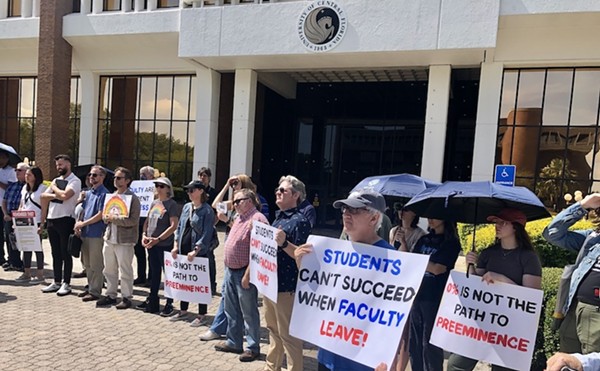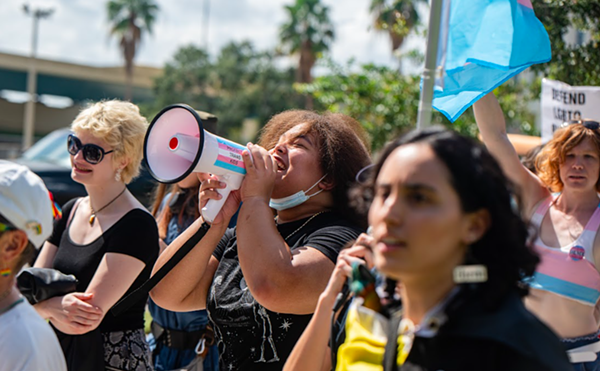The ballerina is missing her head.
It's the first thing you notice when you look at the hastily issued electronic invitation to the very public groundbreaking of the Dr. Phillips Center for the Performing Arts. The extravaganza, scheduled for June 23, marks the latest in a series of controversial chapters befalling a struggling public-private partnership to bring world-class culture to Orlando, come hell or high anxiety. What was once a $383 million multi-pronged project designed to be an arts hub for regional residents of all economic stripes is now a $202 million headless compromise.
What the city is celebrating is a 2,700-seat Broadway theater, a 300-seat black-box theater and ample space for uncertainty. In 2009, the arts component of the project – the 1,700-seat acoustic theater meant to house resident arts groups from the local opera to the symphony and ballet – was shelved indefinitely by DPAC, the nonprofit established more than five years ago to make the center a reality. Even though it was the strongest selling point for the 2007 venues deal that included the now-standing $480 million Amway Center (which hemorrhaged an estimated $1.5 million in its first six months open) and $175 million in Citrus Bowl upgrades (that have yet to happen), the Dr. Phillips Center for the Performing Arts has yet to materialize. The education component, meant to be housed in the complex and used as an outreach to children who don't typically have access to fine arts, is now the stuff of ambitious fiction; it may happen, but it also might just be an empty room in the existing First United Methodist Church building on premises – a building the city spent $30 million to acquire.
If you listen to the prevailing wisdom of the chattering booster class, the abridged version of the Phillips Center remains a vital institution, an economic driver that will prove that Orlando is more than just a family tourism hangover straddling the I-4 corridor.
Even overlooking the fact that people rarely travel to see traveling Broadway productions – shows which are likely to be the bread and butter of the center's operational core – the estimated $200 million in economic impact it is supposed to bring in during its first year of operation (probably 2014) comes off as a stretch. The truth is, according to industry leaders, nobody knows what is going to happen.
What we do know, however, is even less comforting. In the last six months, the project has gotten substantially harder for DPAC staff. A January request that the county come up with a $30 million portion of the $130 million in funding initially expected from the tourism tax prompted a damning pseudo-audit of DPAC operations to date that revealed unseemly wheeling and dealing with the contracted companies. DPAC head Kathy Ramsberger has been relegated to near silence as a new nonprofit comprised of bigwigs from the county, city, the Orlando Magic and Disney – called the Orlando Community Construction Corporation – was thrown together to force the fragmented project to meet its May 23 construction deadline. The move worked (after $16 million in letters of credit were issued via some particularly strident boosters), and now all – including the free lunches, the free car rentals, the upscale party life of a tireless fundraiser – is apparently forgiven. How's that for stagecraft?
And now, it's curtain time. This groundbreaking means one thing: There is no turning back.
But there is some shoring up. On the local front, though DPAC Board Chairman Jim Pugh vowed in front of the Orlando city council in May that he and his peers would be tirelessly working toward $68 million in fundraising to go toward the $102 million he estimated would be required to move forward with the center's acoustic hall, there may not be much of a local arts movement with which to populate it. It's already a struggle to keep an organization fed by discretionary income – be that from ticket sales or fundraising – afloat in a deep recession. Coupled with the philanthropic brass rooting for a financially viable performing arts center, which will require $2 million in annual fundraising to meet its proposed $12 million operations budget, the potential for failure is all too real.
"We are a strong and healthy organization both artistically and financially," says Orlando Philharmonic Orchestra Executive Director David Schillhammer. His orchestra was supposed to find a home in the new center just two years ago, but will now more than likely remain at the Bob Carr Performing Arts Centre (now slated to be programmed and scheduled by DPAC, as well). The Philharmonic has increased its subscriber base from 1,300 to 3,400 over the past four years, says Schillhammer. The group has a $3 million annual operating budget with a $3.7 million endowment, and the orchestra's most recent tax filings from 2009 show $4 million in revenue up from $2.7 million in 2008. Times may be good for the Philharmonic, but DPAC may not be – at least not in its immediate form. An amplified Broadway theater is of no use to a classical orchestra, Schillhammer told the Orlando Weekly last year; also it would require a larger per-seat rental rate than Bob Carr. Regardless, OPO will be providing a string quartet and a brass sextet for this week's groundbreaking, even if it's just to sustain the illusion.
Those who won't be there include the Orlando Opera, which closed its doors in April 2009 after filing for bankruptcy in its 51st year, and the 27-year-old Festival of Orchestras, which followed suit in March. Both were supposed to be resident DPAC companies. The Orlando Ballet, which saw a dip in its revenues from $4.1 million in 2008 to $3.8 million in 2009, is still in operation but appears shaky. In April, ballet Executive Director Juan Escalante stepped down from his post less than two years after taking the job; the company's board of directors declined to comment on that or the company's current finances for this story. Dancers from the ballet, naturally, will be spinning on their toes for the groundbreaking.
"The majority of our donors also support other local arts groups, as well as other causes locally," DPAC spokeswoman Treva Marshall – who also, interestingly, handles public relations for the ballet – says in an email. "For example, one of our major donors – who is also an executive board member – is also a supporter of the Philharmonic."
Marshall goes on to detail that DPAC has no cause for worry. "There is $822 million in philanthropic capacity from the top five wealthiest Central Florida zip codes alone," she writes. "So there is a strong wealth base in this community."
Perhaps, but according to United Arts of Central Florida, annual operational contributions to the area's major arts groups for fiscal year 2011 are only about $7.5 million. DPAC, according to Marshall, is now sitting on $92 million in contributions after five years, with $6 million earmarked for the acoustic hall. Mark Brewer, CEO and president of local nonprofit umbrella the Community Foundation, says that available wealth can be hard to quantify. He estimates that there is $4.6 billion annually in philanthropy available for the seven-county region, but the science of divining just what portion of that is realistic for such endeavors as the performing arts – just like economic impact predictions – is usually suspect.
"There's some wishing, praying and dreaming in there," he says. "There's the assumption that we understand a marketplace that doesn't exist right now."
It may not exist yet, but it's about to – whether it's sustainable or not. In 2005, the Orlando Sentinel issued a "Special Report" outlining the difficulties and triumphs of the performing arts center premise as seen through other markets, culminating in a quote from then-New Jersey Performing Arts Center President and CEO, Lawrence Goldman: "The thing that drives me crazy is people say, ‘If you build it, they will come.' If you build it and do a thousand other things, they will come."
Staring up the skirt of a headless ballerina – juxtaposed with the air-bound torso of a hip-hop dancer, ridiculously – on the invitation for this week's DPAC groundbreaking, you have to wonder just what the performing arts center can do in order to live up to its mutilated mission statement of local arts patronage. The following four performing arts center scenarios represent three possible outcomes and one unlikely victory. As other regional arts groups fold beneath the economic pressures of vanity venues nationwide, unfortunately, we won't know how Orlando compares until it's too late. In fact, it's already too late.
Hold onto your heads and enjoy the show.
ADRIENNE ARSHT CENTER FOR THE PERFORMING ARTS MIAMI
Initially coined the Miami-Dade Performing Arts Center, Miami's preposterous-on-paper performance jewel was already a financial albatross in 2004 – three years after groundbreaking, two years before opening – largely because of construction-cost overruns and poor planning. In June 2004, the Miami Herald reported that the builder responsible for the project had already exhausted the "guaranteed maximum price" of $255 million for the project and was seeking an additional $47-$61 million to bring the majesty to light. Prior to that, the long-delayed project was estimated at a mere $75 million in 1988; it was eventually completed in 2006 at a cost of $473 million and opened as the Carnival Center.
But the center, which was also to house the area arts groups, proved too much of a drain on the local philanthropic economy. Intended resident company, the Florida Philharmonic Orchestra, declared bankruptcy in 2003. In 2009, the Concert Association of Florida also folded. Traveling orchestras from Cleveland and Moscow were brought in as replacements.
Meanwhile, amid very public controversy about the lack of parking and other infrastructural concerns, the center required a $4.1 million bailout in its first year of operation, on top of the $3.75 million it was already guaranteed annually from the county. The center rounded out its first 18 months with a $2.5 million deficit. The entire management team was fired.
A quick reboot came in the form of a $30 million donation from philanthropist Adrienne Arsht (Carnival took its $10 million back) and a streamlining of operations. Miami-Dade County now subsidizes the center, which also pulls funding from other local arts organizations, to the tune of $7 million annually. And yet it continues, experiencing something of a renaissance according to recent reports.
"Even though the Arsht has not cut back, resident companies such as the Miami City Ballet and the Florida Grand Opera have made their own budget cuts in recent years," the Herald reported last year, "and other arts groups that have also cut back during the recession have complained about prohibitively high usage rates."
THE RAYMOND F. KRAVIS CENTER FOR THE PERFORMING ARTS WEST PALM BEACH
The proverbial mansionon the hill in the eyes of DPAC, the Kravis Center opened in 1992 to much fanfare, with performances by Ella Fitzgerald, the Alvin Ailey American Dance Theater, Isaac Stern and the Florida Philharmonic. Initial construction costs were fairly modest; the theater – which includes a 2,200-seat concert hall, a 300-seat black-box theater and an outdoor amphitheater – came in at around $60 million, plus a $30 million renovation that followed in 2003.
But even the best-laid plans of starry-eyed arts advocates couldn't protect the Kravis center from its share of controversy. In 2001, the National Labor Relations Board concluded that the Kravis Center had committed numerous infractions against its unionized stagehands, setting off a contentious battle that lasted for a decade – one that could end up costing the center $3.6 million in damages. Informal picketing continues, most recently in May with an attempt by stagehands to force Bill Maher to cancel a scheduled performance. He didn't.
Kravis' $19 million annual operating budget hasn't been immune to the downward trend in the economy. The most recent tax documents available show a significant drop in grants and donations from $7.1 million in 2007 to $3.9 million in 2008. As for its support of local arts, Ballet Florida, the center's resident ballet company since 1992, closed in 2009 amid massive debt; it was the last company Juan Escalante ran before heading up – then leaving – Orlando Ballet. And just over a year after Florida Stage, a theater company known for developing "new and emerging" works, relocated to the Kravis, it saw its subscription base dip from 7,000 to less than 2,000, leaving the company $1.5 million in the hole. The company shut its doors this month. Local arts supporters point to Kravis as the culprit, suggesting that the resident Palm Beach Opera may be next to go.
AT&T PERFORMING ARTS CENTER DALLAS
Texas' reputation for heft was realized with the erection of the $354 million AT&T Center, which broke ground in 2005 during a fundraising binge and opened its doors in October 2009 with few donations still trickling in. (Donations and grants spiked in 2007 at $67 million.) It was supposed to "polish the city's image," according to early reports. In its first year of operations, the center's expenses were estimated to be around $25 million, with about $5 million of that coming from donations or sponsorships.
According to a January 2010 interview with the center's chief financial officer, Randy Kurtz, in the Dallas Morning News, donations had "virtually stopped" upon the center's opening. Several major donors pulled out. The city of Dallas issued $150 million in bonds toward the center in 2008 and will ultimately take the title to the performing arts complex. Dallas also contributes $2.5 million to the center for operations. By the end of its first year open, the AT&T Center had lost "millions of dollars" according to local media reports.
"It's not a concern," the executive director of the Dallas Arts District told the local ABC affiliate in September. "I mean, none of us want to say that we have a loss, but indeed this is a projected loss."
Though the AT&T Center continues to thrive on the surface – the 2011-2012 Lexus Broadway Series will feature touring Broadway productions of Hair, In the Heights and Green Day's American Idiot, among others – even the city acknowledges that the high-cost life of a performing arts center doesn't suit all local arts groups. In 2012, the city will open the 750-seat City Performance Hall nearby, having issued $40 million in bonds to fund its construction. Though it hasn't even opened its doors yet, the local arts community is already decrying the project's mismanagement.
NEW JERSEY PERFORMING ARTS CENTER NEWARK, New Jersey
At the beginning of a now prescient 2003 email from Ramsberger to Orlando city staff, she quotes Lawrence Goldman, NJPAC's former CEO and president, twice as a prelude to numerically presenting the center's financial model: "The bigger the idea, the easier the fundraising," and "Fund things by what they attract, not cost."
In the case of Newark, a major airport hub for New York City, a case could be made for dreaming big. The experiment worked, but it took a long time. First proposed in 1986 as a suitable home for the local orchestra, symphony, opera, dance and theater groups in need of one, the center's history reads suspiciously like Orlando's present. The NJPAC nonprofit was established in 1988, appointing Goldman as its president in 1989. From the outset, the board was aware that constructing a full project might be a financial drain, so it decided to build it in two phases, beginning with a large hall and a small theater to be designed by architect Barton Myers (DPAC's architect as well). By the time it opened, $60 million had come from public donations and $125 million from federal, state and city contributions. Its opening night gala in 1997 featured Kathleen Battle and Wynton Marsalis, among others, and it was aired on PBS.
By 2009, an additional $182.7 million was raised during a five-year capital campaign, helping to establish an $86.3 million endowment to support operations, maintenance and strategic reserves.
According to its own literature, NJPAC was "conceived as an arts center with a social conscience," that paid special attention to diversity efforts, education and becoming "New Jersey's Town Square" for public engagement with the arts. Its successful marketing campaigns and free shows have brought national notice for minority attendance. Meanwhile, Goldman, who stepped down earlier this year (and was consulted for DPAC), is now charged with commercial development on the surrounding property, while the center continues to thrive. An estimated $28 million dollar annual operating budget remains within reason: Between 2007 and 2008, the center's total revenue jumped from $36 million to $39 million. It is the nation's sixth largest performing arts venue.
The center's slogan? "Just imagine." That's exactly what Orlando is doing right now.


















